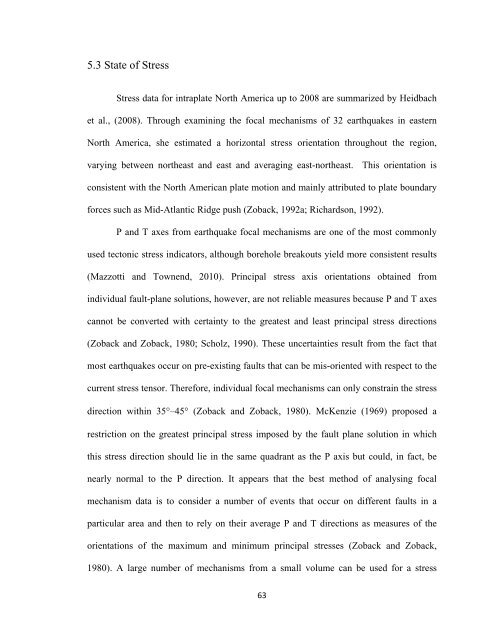western quebec and southern ontario - Department of Geology
western quebec and southern ontario - Department of Geology
western quebec and southern ontario - Department of Geology
Create successful ePaper yourself
Turn your PDF publications into a flip-book with our unique Google optimized e-Paper software.
5.3 State <strong>of</strong> StressStress data for intraplate North America up to 2008 are summarized by Heidbachet al., (2008). Through examining the focal mechanisms <strong>of</strong> 32 earthquakes in easternNorth America, she estimated a horizontal stress orientation throughout the region,varying between northeast <strong>and</strong> east <strong>and</strong> averaging east-northeast. This orientation isconsistent with the North American plate motion <strong>and</strong> mainly attributed to plate boundaryforces such as Mid-Atlantic Ridge push (Zoback, 1992a; Richardson, 1992).P <strong>and</strong> T axes from earthquake focal mechanisms are one <strong>of</strong> the most commonlyused tectonic stress indicators, although borehole breakouts yield more consistent results(Mazzotti <strong>and</strong> Townend, 2010). Principal stress axis orientations obtained fromindividual fault-plane solutions, however, are not reliable measures because P <strong>and</strong> T axescannot be converted with certainty to the greatest <strong>and</strong> least principal stress directions(Zoback <strong>and</strong> Zoback, 1980; Scholz, 1990). These uncertainties result from the fact thatmost earthquakes occur on pre-existing faults that can be mis-oriented with respect to thecurrent stress tensor. Therefore, individual focal mechanisms can only constrain the stressdirection within 35°–45° (Zoback <strong>and</strong> Zoback, 1980). McKenzie (1969) proposed arestriction on the greatest principal stress imposed by the fault plane solution in whichthis stress direction should lie in the same quadrant as the P axis but could, in fact, benearly normal to the P direction. It appears that the best method <strong>of</strong> analysing focalmechanism data is to consider a number <strong>of</strong> events that occur on different faults in aparticular area <strong>and</strong> then to rely on their average P <strong>and</strong> T directions as measures <strong>of</strong> theorientations <strong>of</strong> the maximum <strong>and</strong> minimum principal stresses (Zoback <strong>and</strong> Zoback,1980). A large number <strong>of</strong> mechanisms from a small volume can be used for a stress63
















